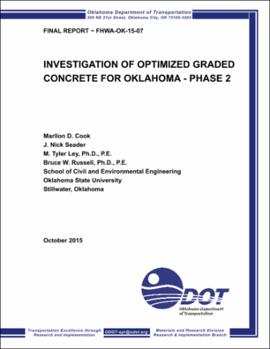| dc.creator | Cook, Marllon D. | |
| dc.creator | Seader, J. Nick | |
| dc.creator | Ley, Tyler M. | |
| dc.creator | Russell, Bruce W. | |
| dc.date.accessioned | 2018-01-24T17:07:56Z | |
| dc.date.available | 2018-01-24T17:07:56Z | |
| dc.date.issued | 2015-10 | |
| dc.identifier.govdoc | FHWA-OK-15-07 | |
| dc.identifier.other | Oklahoma Department of Transportation State Planning and Research item | |
| dc.identifier.uri | https://hdl.handle.net/11244/54316 | |
| dc.description.abstract | Optimizing aggregate usage has been a subject widely discussed through the history of concrete. Since aggregates make up over 70% of the volume in a concrete mixture, the aggregate gradation is critical to the strength, workability, and durability of concrete. In practice, there is little quantitative guidance given to practitioners on aggregate proportioning in a mixture to meet the desired performance. The ACI 211 Mixture Design Procedure maybe the most widely taught mixture design method, but still is not widely used in practice due to limitations with the method. In fact, the ACI 211 method only contains a handful of aggregate parameters that many argue about the validity. One of the largest obstacles preventing the development of aggregate parameters and guidance comes from only a few test methods that are capable of providing quantitative data about the workability of concrete. This work focused on creating practical test methods and using them to understand how the aggregate gradation changes the workability of concrete. | |
| dc.description.abstract | A series of workability tests for concrete were developed/used to investigate mixtures for bridge deck applications. Each test is used to evaluate various aggregate gradations and develop a new set of design recommendations and specifications. | |
| dc.description.abstract | The ultimate product of this work is a new specification for the state of Oklahoma for mixtures with a greater durability at reduced cost and with improved sustainability. Based on 2015 production this design method has the potential to save the state of Oklahoma over $1.5 million per year, enough power for 440 Oklahoma homes, and reduce long term costs through reduced maintenance from durability issues. | |
| dc.format.extent | 156 pages | |
| dc.format.extent | 5,787,682 bytes | |
| dc.format.medium | application.pdf | |
| dc.language | en_US | |
| dc.relation.ispartofseries | No | |
| dc.relation.requires | Adobe Acrobat Reader | |
| dc.relation.uri | http://digitalprairie.ok.gov/cdm/ref/collection/stgovpub/id/517707 | |
| dc.title | INVESTIGATION OF OPTIMIZED GRADED CONCRETE FOR OKLAHOMA - PHASE 2 | |
| dc.type | Technical Report | |
| dc.description.version | Final report, October 2013-October 2015 | |
| dc.description.peerreview | No | |
| dc.type.material | text | |
| dc.subject.keywords | Optimized Graded Concrete | |
| dc.subject.keywords | Aggregate Gradation | |
| dc.contributor.sponsor | Oklahoma Department of Transportation. Materials and Research Division. Office of Research & Implementation | |
